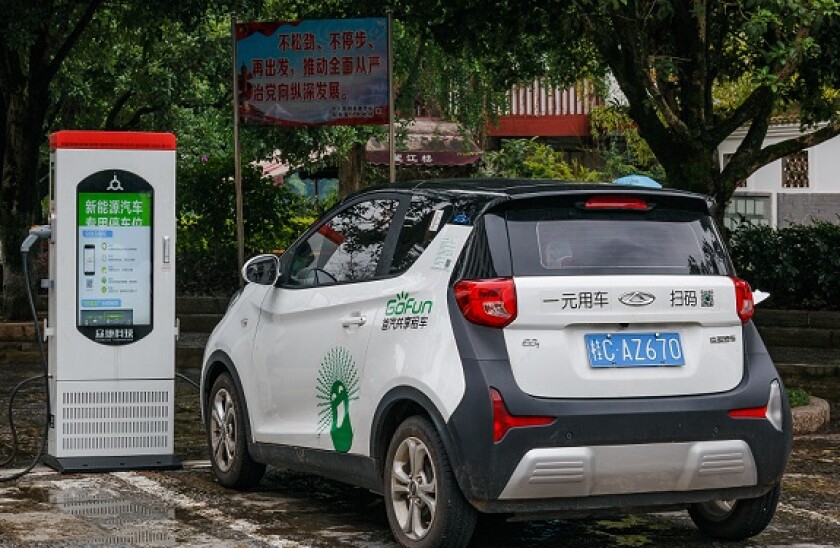The EU and China have produced the first fruits of their labour to make their green finance taxonomies mutually intelligible, and perhaps ultimately to harmonise them, with the publication at COP26 of their first Common Ground Taxonomy. Sustainable finance experts say it could be the beginning of introducing order to the present haphazard proliferation of taxonomies all over the world.
“It’s a guide to the commonality between the European and Chinese taxonomies,” said Sean Kidney, CEO of the Climate Bonds Initiative, a London-based NGO that contributed to the work. “It tells you what’s going to play in each market. There are different structures and approaches, but there’s a lot of commonality.”
So far, 24 countries have begun to develop or use taxonomies to guide their financial sectors on what is sustainable. So have two regional groups — the EU and Asean — and two more: a grouping of multilateral development banks and the Climate Bonds Initiative, the London-based NGO.
These two and China’s are the oldest — they had all begun to take shape by 2015.
But it was when the EU launched its project to create a Taxonomy of Sustainable Economic Activities in March 2018 that the idea began to grip Western financial markets. Since the EU Taxonomy primary legislation was passed at the end of 2019, a wide variety of other countries have copied the concept, including Canada, Japan, Russia, Kazakhstan and South Africa.
Few become many
That the EU’s Taxonomy has led so quickly to such diversity is ironic, since one of the inspirations for its creation was an attempt to make the taxonomies of China, the MDBs and the CBI mutually understandable.
The European Investment Bank was working on that effort in 2017 with Chinese partners, the CBI and the Institute for Climate Economics. At the time, Aldo Romani, then deputy head of funding at the EIB in Luxembourg, said: “Our idea is to create a Rosetta Stone of the existing taxonomies.”
Already, market participants sensed the need for markets in different regions to speak the same language, to encourage cross-border green investment.
Four years later, taxonomies have grown into a worldwide industry, with thousands of people striving to craft them, lobby about them and work out how to use them. In this very different context, a new version of that Rosetta Stone has appeared.
The Common Ground Taxonomy (CGT) is the first in depth report that shows how the two taxonomies map on to each other — which areas are covered by both or only one. Where there is overlap, it shows which criteria are more stringent.
“It’s first and foremost intended to set up a common language for the world in talking about taxonomies,” said Byford Tsang, China strategy expert at E3G, the climate change think tank, in London. “Now Japan and other countries have their own taxonomies and it’s increasing transaction costs. But China is also keen to develop cross-border flows of capital. And China wants to develop its own green finance sector, so this is an opportunity to take best practice from different places.”
Global outreach
The CGT has been produced by the International Platform on Sustainable Finance, (IPSF) an organisation designed to fulfil the EU’s ambition to have a global leg to its swathe of sustainable finance regulation activities, begun in 2018.
The IPSF was launched at the IMF/World Bank annual meetings in Washington in October 2019 by the EU and the relevant authorities from China, India, Kenya, Morocco, Canada, Chile and Argentina.
Since then, 10 more territories have joined, including Hong Kong, Singapore, the UK, Indonesia, Malaysia and Japan. Together, they have 55% of world GDP and greenhouse gas emissions and 50% of population. The US is not a member.
It is essentially a forum for regulators and policymakers working on sustainable finance to share ideas and co-operate. This year, the IPSF’s work has had two key priorities: sustainability disclosures and comparing taxonomies.
The core element of the taxonomy work has been a project led by Marcel Haag, deputy director-general in the European Commission’s Directorate-General for Financial Services (DG Fisma) and Ma Jun, professor at Tsinghua University, on behalf of the People’s Bank of China, which represents China in the IPSF.
For the EU side, much of the work was done by Kidney, Bridget Boulle and Wenhong Xie of the Climate Bonds Initiative.
First step
The report last week is just the first stage of the work. It only covers a subset of the activities described in each taxonomy. The work will continue, but already market participants believe valuable results could come from it.
“One of the things the report stressed is that there is a need to align under the same set of industry classification codes,” said Tsang.
The EU taxonomy uses its Nace system of industrial classifications. The Chinese catalogue uses a bespoke one, not linked directly to China’s industrial classification system.
The researchers had to begin by mapping each of these to the international Isic system.
“It’s like Python and HTML,” said Kidney. “Somebody’s got to do a device to match them up. It’s a pain in the neck, but we already have that pain because every region uses a different industry classification. This will drive harmonisation.”
Concentrating on overlaps
The EU and Chinese taxonomies overlap, but each covers activities that the other does not. So far, the Chinese one, known as the Green Projects Catalogue, is broader, because it addresses a wide range of green priorities, including water conservation and biodiversity. The EU has proceeded more slowly, and so far only completed two sections of its taxonomy, concerning climate change mitigation and climate change adaptation.
The study analyses only activities that are covered in both the EU’s climate change mitigation chapter and the Chinese taxonomy — and then only a subset of 80 activities in six sectors that the working group decided had high impact: agriculture, forestry and fishing; manufacturing; electricity, gas, steam and air conditioning supply; water, sewage and waste; construction; and transport and storage.
For these activities, the group compared the criteria used on each side to determine whether something was making, in the EU’s language, a “substantial contribution” to climate change mitigation.
They did not examine the additional conditions required to get into the EU Taxonomy — that an activity should “do no significant harm” (DNSH) to any of the other environmental objectives, such as biodiversity, and that it should satisfy “minimum safeguards” on human rights.
China does not have a direct equivalent, but initial analysis suggests there are criteria that could be compared in future.
Observers said China had showed interest in considering the value of DNSH criteria for its own system.
Best of both
The report comprises a 43 page explanatory document and a 62 page appendix containing tables for each of the activities, stating whether, in each case, the EU or Chinese criteria are more stringent.
The document thus comprises an embryonic version of a Common Ground Taxonomy that would satisfy a user following either the Chinese or the EU code — subject to the addition of DNSH and safeguard checks.
The publications are loaded with caveats that readers should not make the mistake of thinking the CGT is comprehensive, or has any legal standing. Rather, it is “an evolving tool that may help different actors to understand the types of activities that could be covered under the respective taxonomies within the scope of the comparison exercise”.
The report and comparison tables are out for consultation until January.
For the time being, they will not change much in actual market practice. Firms in every country will still have to follow the rules that apply to them locally.
But, Tsang said, “it is a signal that there will be more of a convergence of the different taxonomies, and awareness about it from different countries. The IPSF has about 20 countries in it, so it will have an impact beyond the EU and China.”
Potential standard
The IPSF work could also feed into what is being done in the G20’s Working Group on Sustainable Finance. That has some of the same aims, but a different membership. It is co-chaired at the moment by China and the US.
Through this body, Tsang said, China was “taking on broad leadership in designing and shaping global rules for markets and banks”.
Kidney agreed that the real significance of the CGT was the interest third countries were taking in it. Representatives from Japan, India, Singapore and others had joined the working groups on it.
“Of all the Taxonomies in the world, the Chinese and EU ones are quite different,” Kidney said. “The European one is more modelled on the CBI’s — the Chinese is quite different.”
Apart from Mongolia’s, which followed the Chinese example, all the others were modelled on the EU/CBI approach, Kidney said.
“So if we can get these two aligned, everyone else falls into place,” he said. “For everyone doing a Taxonomy around the world, this becomes a default.”





